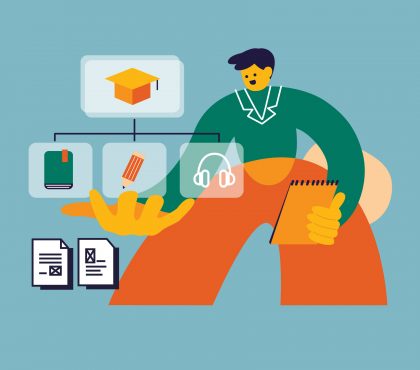5 tips to develop new hire training programs in a fast growth context
1. Understand your business needs during fast growth periods
During these periods, you may be hiring a large number of new employees in a short time, which can be overwhelming for your department, HR team, and new hires. Here are some key considerations when designing a new hire training program for a fast growth period:
- Scalability: Your training program should be designed with a scalability mindset so you can onboard new hires quickly and efficiently.
- Standardization: To streamline your training program, consider standardizing the training process as much as possible, while tailoring it to each job role.
- Flexibility: Even with standardization, your training program should be flexible enough to adapt to changes in your business needs and the individual needs of your new hires.
- Time-Saving: To save time for both your HR team and your new hires, consider using technology, such as online training modules or videos, to deliver your training program.
- Contextualization: In the case of startup business models, their products may be unique and innovative. It’s hard to find references to build a training program. You should involve current excellent employees to build up training materials that fit the organization’s context.
2. Designing a custom new hire training program for fast growth
There are several challenges when designing a new hire training program, including ensuring consistency and quality of training across different locations and departments and keeping up with industry changes and regulations. Here are some steps to consider when designing your program:
- Identify key training topics and skills:
A fast-growing manufacturing company might prioritize safety training for new hires in their production facilities. A business that is rapidly expanding its customer base may prioritize customer relationship management training. In a fast growth period, time is of the essence. Thus, prioritizing the learning objectives can help streamline the training process. It’s essential to identify the specific skills and knowledge that your new hires need to be successful in their roles quickly.
- Choose the right format to scale up training:
Consider using a blended learning approach that includes online modules, in-person training, and on-the-job training. This approach can help you scale your training efforts quickly and efficiently. For example, you may create online modules covering job responsibilities, followed by in-person training focusing on more complex tasks. Then on-the-job training allows new hires to apply what they’ve learned in a real-world setting.
One QBE, one of F.Learning’s clients, chooses animation to deliver the knowledge of using a management tool. They believe animation is the most suitable format to train 14,500 employees globally.
- Develop engaging content:
During fast growth periods, your new hires are under pressure to learn quickly while handling their regular job responsibilities. You can develop relevant, interactive, and visually appealing content to keep new hires engaged and motivated. For example, you may create videos that show new hires how to complete tasks, followed by quizzes that test their knowledge. Then, use case studies that show how your business has solved common problems. Finally, create simulations that allow them to practice skills in a safe environment.
- Measure and evaluate:
In a fast-growth context, you don’t have time to perfect your training program before deploying it. Thus, measure the effectiveness of your program and evaluate the results so that you can make adjustments as needed. For example, you may conduct surveys to get feedback from new hires, track performance metrics such as time to productivity or retention rates, and ask managers to see how new hires perform on the job.
3. Delivering the new hire training program
In this phase, the difficult thing is to balance standardization and flexibility. Here are some key insights to keep in mind when delivering your new hire training program:
- Personalization:
Every new hire is unique, with their own set of skills and learning styles. It may be tempting to release a one-size-fits-all training program to save time and resources. However, personalized training can be more effective in engaging new hires and helping them retain information. Consider using tools like pre-assessments to identify knowledge gaps and tailor training content accordingly.
- Gamification:
Gamification is a growing trend in the world of corporate training. It involves incorporating game-like elements, such as points, badges, and leaderboards, into training programs to make learning more engaging and fun. In a fast growth period, gamification will keep new hires motivated and interested in their training.
- Just-in-time learning:
In a fast growth period, prioritizing time and efficiency is a must. Just-in-time learning is a learning model that emphasizes delivering information at the moment of need. Instead of providing comprehensive training programs, just-in-time learning provides quick and accessible resources, such as job aids and micro-learning modules, that employees can access when they need help with specific tasks.
- Mentorship:
New hires may feel overwhelmed or isolated in a fast-paced, high-growth environment. Mentorship programs support new employees and help them acclimate to the company culture. Assigning mentors to new hires can provide them with valuable resources for guidance, feedback, and support.
4. Measuring the success of your training in a fast-growth business
Measuring the success of a new hire training program during fast growth can be challenging due to limited resources, lack of time, and the need for quick results. Additionally, you need to determine the impact of training on overall business performance and identify which metrics to use to evaluate success. Measurement also includes ensuring the alignment of training with changing business needs and industry standards. Here are some ways to measure the success of your new hire training program in a fast growth business:
- Time to Productivity:
One way to measure the success of your new hire training program is to track the time it takes for new hires to become productive. In a fast-paced business, it’s crucial to get new hires up to speed so that they can start contributing to the business’s growth. By tracking the time it takes for new hires to become productive, you can assess the effectiveness of your training program and identify areas for improvement.
- Employee Retention:
Retention is a critical metric during growth, as losing valuable employees can affect the company’s growth. By measuring the retention rate of new hires, you can assess the effectiveness of your training program in keeping employees engaged and motivated. If new hires leave the company right after completing the training program, the program doesn’t meet their needs or expectations.
- Feedback from Employees and Managers:
Gathering feedback from new hires and their managers can provide valuable insights into the effectiveness of your training program. By asking for feedback on the training program’s content, delivery, and performance, you can identify areas for improvement. Moreover, you can make adjustments to ensure that the program meets the needs of new hires and the business.
- Business Impact:
Ultimately, the success of your new hire training program in a fast growth business can be measured by its impact on the business’s growth. By tracking key performance indicators (KPIs) such as revenue growth, customer satisfaction, and employee productivity, you can assess the overall impact of the training program on the business’s bottom line.
Conclusion
New hire training is crucial for fast-growth businesses. By partnering with F.Learning Studio, you can ensure that your new hires are onboarded quickly and efficiently, enabling them to contribute to the growth of your business as soon as possible.
If you are thinking of getting your own video, check out our onboarding videos solution for more information and free consulting.
Read more:




